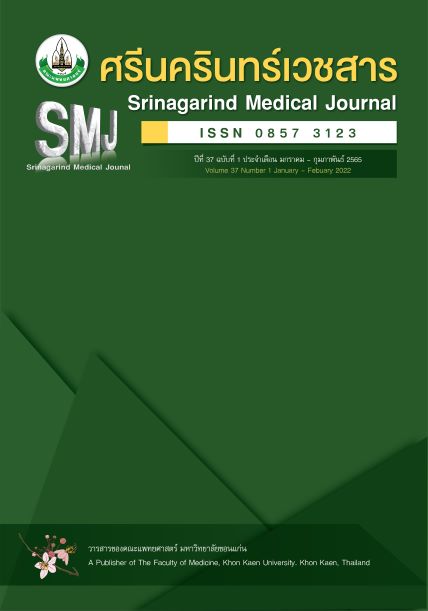ผลลัพธ์การดูแลทารกปากแหว่งเพดานโหว่ในหอผู้ป่วยกึ่งวิกฤติทารกแรกเกิด โรงพยาบาลศรีนครินทร์ มหาวิทยาลัยขอนแก่น
Abstract
Outcomes of Care for Infants with Cleft Lip and Palate in the Intermediate Care and Special Care Nursery at Srinagarind Hospital, Khon Kaen University
หลักการและวัตถุประสงค์: ทีมหลักในการดูแลทารกปากแหว่งเพดานโหว่ในหอผู้ป่วยกึ่งวิกฤติทารกแรกเกิด คือ กุมารแพทย์และพยาบาลเพื่อให้ปลอดภัย และดูแลต่อเนื่องร่วมกับทีมสหวิทยาการ การศึกษานี้มีวัตถุประสงค์เพื่อศึกษาผลลัพธ์การดูแลทารกปากแหว่งเพดานโหว่แบบสหวิทยาการ
วิธีการศึกษา: การศึกษาแบบตัดขวางในหอผู้ป่วยกึ่งวิกฤติทารกแรกเกิด โดยทบทวนจากแฟ้มประวัติ เวชระเบียน ข้อมูลสารสนเทศโรงพยาบาล และแบบบันทึกการพยาบาลของมารดาและทารกในช่วง 3 ปี วิเคราะห์ข้อมูลเชิงปริมาณโดยใช้สถิติร้อยละ ค่าเฉลี่ย และสรุปวิเคราะห์ข้อมูลเชิงคุณภาพ
ผลการศึกษา: มารดา 10 ราย คลอดในโรงพยาบาล 9 ราย ผ่าคลอด 7 ราย ตั้งครรภ์เฉลี่ย 2.4 ครั้ง อายุครรภ์เฉลี่ย 36.1 สัปดาห์ อาศัยในจังหวัดขอนแก่น 6 ราย ทารกที่เข้ารับการรักษาคิดเป็นสัดส่วนของผู้ป่วยแต่ละปี คือ 8.09, 3.14 และ 4.60 ต่อ 1,000 ราย เป็นเพศหญิง 7 ราย น้ำหนักแรกคลอดอยู่ในเกณฑ์เฉลี่ย 2,685 กรัม วันจำหน่ายต่ำกว่าเกณฑ์เฉลี่ยคือ 3,171 กรัม นอนโรงพยาบาลเฉลี่ย 39.3 วัน มีภาวะปากแหว่งเพดานโหว่ชนิดสมบูรณ์สองข้าง และภาวะปิแอร์-โรแบง อย่างละ 3 ราย มีทีมสหวิทยาการร่วมดูแล 9 ทีม รอดชีวิต ได้รับการผ่าตัด และติดตามการรักษาต่อเนื่องทั้ง 10 ราย
สรุป: มีทารกปากแหว่งเพดานโหว่เข้ารับการรักษาในหอผู้ป่วยกึ่งวิกฤติทารกแรกเกิดจำนวนไม่มาก แต่ทารกมีกลุ่มอาการร่วมและซับซ้อน การดูแลต้องใช้ทรัพยากรจำนวนมาก และร่วมกันดูแลแบบสหวิทยาการ ซึ่งผู้ป่วยมีความปลอดภัย ได้รับการผ่าตัดและติดตามการรักษาต่อเนื่อง
คำสำคัญ: ทารกปากแหว่งเพดานโหว่, หอผู้ป่วยกึ่งวิกฤติทารกแรกเกิด, ทีมสหวิทยาการ, ศูนย์ตะวันฉาย
Background and objective: The care team for infants with cleft lip and palate in the Intermediate Care and Special Care Nursery are pediatricians and nurses to keep them safe. This study aimed to analyze the outcomes of care for infants with cleft lip.
Method: A cross-sectional study in the Intermediate Care and Special Care Nursery, by reviewing the history files, medical records, hospital information, and the nurse note form of mothers and infants during 3 years. Quantitative data were analyzed using percentage, mean and qualitative summary.
Results: Ten mothers, nine cases gave birth in Hospital, seven cases had cesarean sections, pregnancies average 2.4 times, gestational age average was 36.1 weeks, six cases were in Khon Kaen. The proportion of infants admitted to the wards each year was 8.09, 3.14 and 4.60 per 1,000, seven females, with average birth weight of 2,685 g, date of discharge below the mean, weight 3,171 g., and an average hospital stay of 39.3 days.
Conclusion: Infants with CLP were admitted to a small number of the Intermediate Care and Special Care Nursery but had associated malformations and complicated syndromes. Caring requires a large number of resources and is shared by a multidisciplinary team, the patients received the surgery safely and continued treatment.
Keywords: Infants with cleft lip and palate, Intermediate Care and Special Care Nursery, Multidisciplinary team, Tawanchai Center


